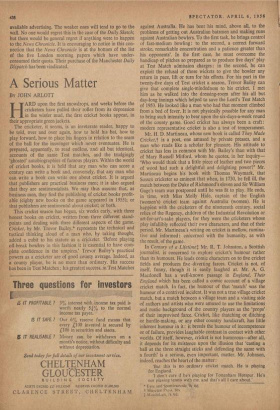Newsprint News
13', RANDOLPH S. CHURCHILL FOR years the British press have clamoured for more newsprint. Recently the allocations have been somewhat increased and particularly for the mass circulation papers which have in the last few months increased their price from 11d. to 2d. These include the News Chronicle, Daily Herald and Daily Mirror which went to 2d. on September 19, 1955, and also the Daily Express and Daily Mail which followed suit four and a half months later. When these papers sold at 11{1. they were allowed an average con- sumption of nine pages a day. At 2d. they are entitled to eleven and a quarter. The Times, by changing over to 'mechanical paper,' i.e., comparable with that used by some magazines such as Picture Post, is no longer dependent on newsprint and receives a considerably higher allocation than it had before, or than it would have now if it had stuck to newsprint.
The new allocation period covers a period of twenty-four weeks from March 5 to August 18. In order to allow for seasonal and advertising flexibility the papers are allowed to use their total twenty-four weeks' allocation as they like. It is interesting to see what their varying consumptions have been during the first three weeks of the allocation up to Saturday, March 24. The following table shows the position in both the morning and the evening fields : PAGING CONSUMPTION FOR CURRENT QUOTA PERIOD
LONDON MORNING PAPERS News Espresq Mail Herald Chron. Times Tel. Mirror Sketch Allowance 1,620 1,620 1,620 1,620 3,024 1,620 3,240 3,240 Used to date
(March 24) 212 218 188 192 328 212 360 288 Overconsumed 91 151 9/
Underconsumcd 141 101 50 45 117 LONDON EVENING PAPERS
Evening Evening
Standard News
Star
Allowance .. 3,240 • •• 1,620
3,240
Used to date 412 254
• .:
372
Overconsumed 7 • .1 511
Underconsumed
33
The lessons to be learnt from the above table are clear. In the morning field the Daily Mail, the Daily Telegraph and the Daily Express are all using slightly more than their daily average allocation. So in the evening field are the Evening News and the Evening Standard, particularly the former. All newspapers publish smaller papers during the first two weeks in August and suffer no inconvenience in economising then as they will also have done over the Easter holidays. What of the papers which have under-consumed? The outstanding ones are the Daily Sketch, The Times and the Daily Mirror. What does this mean? In the case of the Daily Sketch and The Times it is certain that the reason is that they cannot get the adver- tising at their present rates to justify the consumption of their full daily quota. In the case of the Daily Mirror the explana- tion is different. The Mirror is experiencing mechanical diffi- culties in bringing out bigger papers. However, it is grappling with this and the difficulties will probably be overcome in the near future.
There is nothing decisive about these figures, but they do serve as a guide as to which are the strong papers and which are the weak. And they give a foretaste of what is likely to happen when newsprint rationing is eventually, if ever, removed. The strong papers will be able to publish much bigger issues and will mop up an ever-increasing share of the available advertising. The weaker ones will tend to go to the wall. No one would regret this in the case of the Daily Sketch; but there would be general regret if anything were to happen to the News Chronicle. It is encouraging to notice in this con- nection that the News Chronicle is at the bottom of the list of the five London morning papers which have under- consumed their quota. Their purchase of the Manchester Daily Dispatch has been vindicated.

















































 Previous page
Previous page